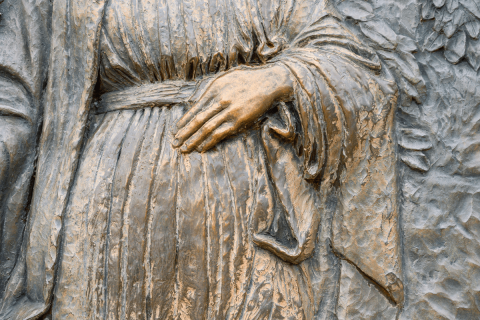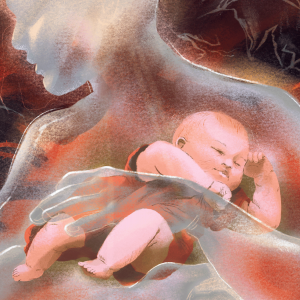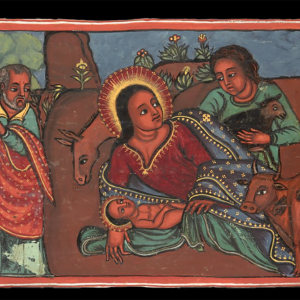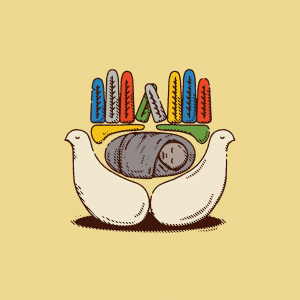
Birth is messy and visceral—and Jesus showed up in the middle of it.

A LOT OF BEGGING happens at Christmas. There are pleas in the toy aisle and hints left open on laptops. But no one begs to be in labor. Not even a woman who is pregnant. Unless, of course, she is at the bitter end of her pregnancy.
In the language of King James, Luke tells us that Mary is not just pregnant, but she is “great with child” (Luke 2:5). She is on the cusp of birthing, of being the first one to slide her hands up under the armpits of the warm, slippery flesh of God. No one before or after will have God in quite this way.
In Mary, the Word became flesh and was born in the most mundane, most primal human act. This flesh must count for something. The extremely pregnant body of Mary — great with child — reveals the nature of our waiting for Christ and what it might mean to cry out for Jesus’ coming.
“It is profoundly significant that Jesus was born not in a secure, two-income household but to an unwed teenage mother.”

I’ll never forget the day my first son was born. Joshua was more than a week late, so my wife’s doctor wanted to induce labor. After a long day of waiting, the nurses convinced me to get a bite to eat because it was likely to be an even longer night. Minutes later, I got a frantic call that my wife, Sharee, was undergoing an emergency cesarean section because Joshua’s heart rate had suddenly plummeted, and his umbilical cord was wrapped around his throat. That day marked the beginning of my journey as a father, the most rewarding and demanding experience of my life. Joshua immediately became the center of our world, as though a huge part of my own heart were living and breathing outside of myself.
The love I feel for my sons is the closest I have felt to God’s unconditional love for everyone. I knew instinctively from the moment I first held my son in my arms that I would do everything possible to ensure that this tiny, fragile person, who was completely dependent on our care, was protected, loved, and able to thrive.
A poem.

What moved me the most was a tiny hand,
like the claw of a cub, pawing at my
rib cage in time to the suckle of his lips.
This beautiful, wild person sustained
by milk drawn from unknown wells within me.
I remember nursing once in the basement
restroom of the zoo’s primate house.
The floor tile was cold — no other place to sit.
As we anticipate the birth of Jesus Christ, we must remember that God appeared in these tender places — in human flesh, in the womb of a refugee, at the site of vulnerability and oppression.

IN THE EIGHTH season of Call the Midwife, set in post-war east London, nuns and nurse midwives of Nonnatus House assist a woman with severe complications from a “backstreet” abortion. Sister Julienne says to a young nurse, “The word ‘midwife’ means ‘with-woman.’ A woman in that situation needs somebody by her side.”
I’m pro-choice, which was an unpopular stance in the Catholic community I grew up in. For my views on reproductive rights, people in youth group called me a “baby killer” and “Pontius Pilate.” During Advent, specifically, I loathed the hollow teachings on Mary and childbirth. We sanitized the Nativity into a cute story — the equivalent of a Disney movie featuring a white family and a manger crowded with men. Only recently did I learn that some scholars believe that midwives attended Jesus’ birth. As reproductive freedom and care are further undermined in the United States, this is an apt time to reclaim a more feminist view of the Nativity and rethink Advent as the season of the midwife.

When I was in labor with my third child, my older sister was bewildered by my pain. As I walked the hall of our two-story row house in southwest Philadelphia, seeking moments of comfort between birth pool and bed, couch and floor, she said to me, “But, you’ve already done this before. Why is it so hard?”
“I haven’t birthed this baby!” I cried out to her. Then I settled into a deep silence, preparing myself for the next wave, the next earth-shaking moan.

One of the most familiar biblical passages to be read during Advent is from Isaiah 9:6: “For to us a child is born, to us a son is given, and the government will be on his shoulders. And he will be called Wonderful Counselor, Mighty God, Everlasting Father, Prince of Peace.”
At the time it was spoken, the whole world was falling apart, or so it seemed to the eighth-century prophet Isaiah. Looking over history at a string of failed rulers, and staring into the abyss at ongoing chaos and political disaster, Isaiah looked forward to a time when God would send an heir to the throne who would be a different kind of ruler, a divinely appointed one (the Messiah), and his name would tell his character. Isaiah promised a people whose hope was failing that a baby would be born.
But where do babies come from? They come from women, women who endure the discomforts of pregnancy and the excruciating pain of labor to bring forth life.